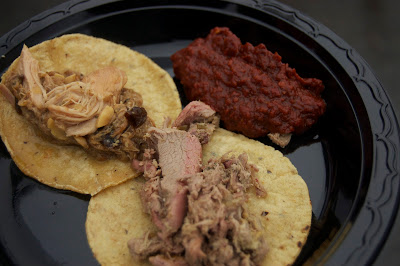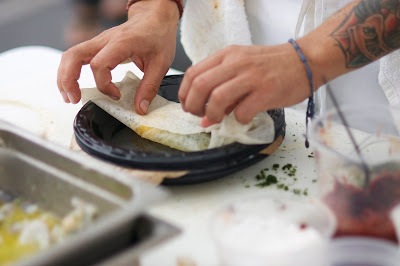The recent couscous festival was a bang, with an abundance of wonderful North African food and music and a great positive vibe. But I’ve heard several people–people who weren’t there–comment, “I like couscous, but why would you devote an entire festival to it?”
It’s like this: What rice is to Asians and what corn is to Native Americans, couscous is to North Africans. It is such an integral part of the culture that it transcends being a mere ingredient in a dish. It’s elemental–in fact, I’ve found that the words in several North African dialects for “couscous” are interchangeable with the word “food.” It’s THE food of the Maghreb, that is, a good portion of the Sahara and what’s above it.
chicken and beef cheeks braised in tagines and served with couscous
We’re not talking about that five-minute instant stuff you mix with boiling water. Authentically prepared couscous is steamed for three hours, over either broth or water; every 30 minutes it is fluffed and massaged with a bit of oil, and put back in to steam until 30 minutes later, when the process begins all over again. The result is couscous that is perfectly hydrated–light and fluffy, not soggy and leaden. And amazingly flavorful.
Couscous is good in either savory or sweet dishes, so you might have a bed of couscous soaked with the juices of braised lamb and a generous serving of lamb perched on top for dinner, followed by more couscous mixed with honey, spices, fresh fruit, rosewater–you name it–for dessert. It has great versatility.
Yeah, I know this photo is out of focus, but it expresses so well the character of authentic couscous, which looks like it could just fly right off your plate–it DOES, actually!
I assumed that couscous was a pasta, but it turns out that it’s not. Rather, it’s a grain, semolina wheat, that has been rolled by hand in what is quite a labor-intensive process. Couscous first showed up in 13th century Spanish and Syrian writings and is thought to have originated with the Berbers, North Africa’s indigenous people. It didn’t take long to spread from there, to become a staple of cuisines throughout the Mediterranean and beyond. Couscous is high-gluten and low-moisture, so it keeps well in harsh environments, perfect for the desert.
Tagines are earthenware vessels used for cooking meat until it is succulent and juicy, perfect for topping a plate of couscous. Vegetables cook up nicely in them, too.
Couscous made a good point of departure for sampling more North African cuisine and exploring different styles of cooking. The rabbit with currants and pine nuts was cooked in tagines, while the lamb was smoked whole in a giant smoker. Traditionally it would have been spit roasted, but the sheer volume required for the festival necessitated stationing a large smoker in the parking lot. The point was to present slow cooked lamb, so I’d say mission accomplished!
Rabbit and lamb on corn tortillas (a concession to the Southwest!) with a generous dollop of harissa, a condiment made of pounded chili peppers.
Assembling a briq (by the way, while the expression goes, “Never trust a skinny chef,” I frankly don’t think I’d trust one without some serious tatts!)
Also on the menu was the briq, a thin crepe-like pastry of durum wheat filled with bites of food (shrimp in this case), a dollop of harissa and a raw egg…
…and folded into a tidy package before cooking. It is placed in the shallow side of a pan tilted over a fire with hot grease. You spoon the grease over the briq as it cooks so that it cooks quickly but without becoming soggy.
mmmm, briq!
Confession time: Between you and me, I adore couscous made the proper way, but I can’t devote three hours of cooking every time I want some. So I’ll have to get by on the quick stuff, until I can make it out to a Moroccan restaurant–or back to next year’s couscous festival. I’ll be there, and I’ll be sure to be hungry when I get there.
This entry was posted in Uncategorized and tagged
briq,
couscous,
couscous festival,
harissa,
lamb,
rabbit,
tagine. Bookmark the
permalink.























